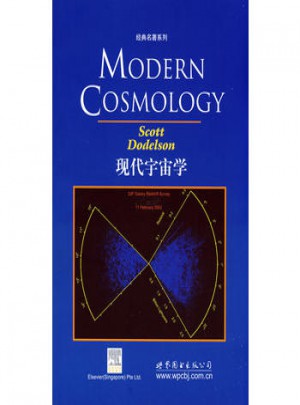

There are two aspects of cosmology today that make it more alluring than ever. First, there is an enormous amount of data. To give just one example of how rapidly our knowledge of the structure of the universe is advancing, consider galaxy surveys which map the sky. In 1985, the state-of-the-art survey was the one carried out by the Center for Astrophysics; it consisted of the positions of 1100 galaxies. Today, the Sloan Digital Sky Survey and the Two Degree Field between them have recorded the 3D positions of half a million galaxies.
作者簡介:
Scott Dodelson is Head of the Theoretical Astrophysics Group at Fermilab and Associate Professor in the Department of Astronomy and Astrophysics at the University of Chicago.He received his Ph.D. from Columbia University and was a research fellow at Harvard before coming to Fermilab and Chicago. He is the author of more than seventy papers on cosmology, most of which focused on the cosmic microwave background and the large scale structure of the universe. Dodelson is a theoretical cosmologist, but has worked with several experiments, including the Sloan Digital Sky Survey and the Python and MSAM anisotropy experiments.
1 The Standard Model and Beyond
1.1 The Expanding Universe
1.2 The Hubble Diagram
1.3 Big Bang Nucleosynthesis
1.4 The Cosmic Microwave Background
1.5 Beyond the Standard Model
1.6 Summary
Exercises
2 The Smooth, Expanding Universe
2.1 General Relativity
2.1.1 The Metric
2.1.2 The Geodesic Equation
2.1.3 Einstein Equations
2.2 Distances
2.3 Evolution of Energy
2.4 Cosmic Inventory
2.4.1 Photons
2.4.2 Baryons
2.4.3 Matter
2.4.4 Neutrinos
2.4.5 Dark Energy
2.4.6 Epoch of Matter-Radiation Equality
2.5 Summary
Exercises
3 Beyond Equilibrium
3.1 Boltzmann Equation for Annihilation
3.2 Big Bang Nucleosynthesis
3.2.1 Neutron Abundance
3.2.2 Light Element Abundances
3.3 Recombination
3.4 Dark Matter
3.5 Summary
Exercises
4 The Boltzmann Equations
4.1 The Boltzmann Equation for the Harmonic Oscillator
4.2 The Collisionless Boltzmann Equation for Photons
4.2.1 Zero-Order Equation
4.2.2 First-Order Equation
4.3 Collision Terms: Compton Scattering
4.4 The Boltzmann EqUation for Photons
4.5 The Boltzmann Equation for Cold Dark Matter
4.6 The Boltzmann Equation for Baryons
4.7 Summary
Exercises
5 Einstein Equations
5.1 The Perturbed Ricci Tensor and Scalar
5.1.1 Christoffel Symbols
5.1.2 Ricci Tensor
5.2 Two Components of the Einstein Equations
5.3 Tensor Perturbations
5.3.1 Christoffel Symbols for Tensor Perturbations
5.3.2 Ricci Tensor for Tensor Perturbations
5.3.3 Einstein Equations for Tensor Perturbations
5.4 The Decomposition Theorem
5.5 From Gauge to Gauge
5.6 Summary
Exercises
6 Initial Conditions
6.1 The Einstein-Boltzmann Equations at Early Times
6.2 The Horizon
6.3 Inflation
6.3.1 A Solution to the Horizon Problem
6.3.2 Negative Pressure
6.3.3 Implementation with a Scalar Field
6.4 Gravity Wave Production
6.4.1 Quantizing the Harmonic Oscillator
6.4.2 Tensor Perturbations
6.5 Scalar Perturbations
6.5.1 Scalar Field Perturbations around a Smooth Background
6.5.2 Super-Horizon Perturbations
6.5.3 Spatially Flat Slicing
6.6 Summary and Spectral Indices
Exercises
7 Inhomogeneities
7.1 Prelude
7.1.1 Three Stages of Evolution
7.1.2 Method
7.2 Large Scales
7.2.1 Super-horizon Solution
7.2.2 Through Horizon Crossing
7.3 Small Scales
7.3.1 Horizon Crossing
7.3.2 Sub-horizon Evolution
7.4 Numerical Results and Fits
7.5 Growth Function
7.6 Beyond Cold Dark Matter
7.6.1 Baryons
7.6.2 Massive Neutrinos
7.6.3 Dark Energy
Exercises
8 Anisotropies
8.1 Overview
8.2 Large-Scale Anisotropies
8.3 Acoustic Oscillations
8.3.1 Tightly Coupled Limit of the Boltzmann Equations
8.3.2 Tightly Coupled Solutions
8.4 Diffusion Damping
8.5 Inhomogeneities to Anisotropies
8.5.1 Free Streaming
8.5.2 The Cl's
8.6 The Anisotropy Spectrum Today
8.6.1 Sachs-Wolfe Effect
8.6.2 Small Scales
8.7 Cosmological Parameters
8.7.1 Curvature
8.7.2 Degenerate Parameters
8.7.3 Distinct Imprints
Exercises
9 Probes of Inhomogeneities
9.1 Angular Correlations
9.2 Peculiar Velocities
9.3 Direct Measurements of Peculiar Velocities
9.4 Redshift Space Distortions
9.5 Galaxy Clusters
Exercises
10 Weak Lensing and Polarization
10.1 Gravitational Distortion of Images
10.2 GeodesiCs and Shear
10.3 Ellipticity as an Estimator of Shear
10.4 Weak Lensing Power Spectrum
10.5 Polarization: The Quadrupole and the Q/U DecompositioI
10.6 Polarization from a Single Plane Wave
10.7 Boltzmann Solution
10.8 Polarization Power Spectra
10.9 Detecting Gravity Waves
Exercises
11 Analysis
11.1 The Likelihood Function
11.1.1 Simple Example
11.1.2 CMB Likelihood
11.1.3 Galaxy Surveys
11.2 Signal Covariance Matrix
11.2.1 CMB Window Functions
11.2.2 Examples of CMB Window Functions
11.2.3 Window Functions for Galaxy Surveys
11.2.4 Summary
11.3 Estimating the Likelihood Function
11.3.1 Karhunen-Loeve Techniques
11.3.2 Optimal Quadratic Estimator
11.4 The Fisher Matrix: Limits and Applications
11.4.1 CMB
11.4.2 Galaxy Surveys
11.4.3 Forecasting
11.5 Mapmaking and Inversion
11.6 Systematics
11.6.1 Foregrounds
11.6.2 Mode Subtraction
Exercises
A Solutions to Selected Problems
B Numbers
B.1 Physical Constants
B.2 Cosmological Constants
C Special Functions
C.1 Legendre Polynomials
C.2 Spherical Harmonics
C.3 Spherical Bessel Functions
C.4 Fourier Transforms
C.5 Miscellaneous
D Symbols
Bibliography
Index